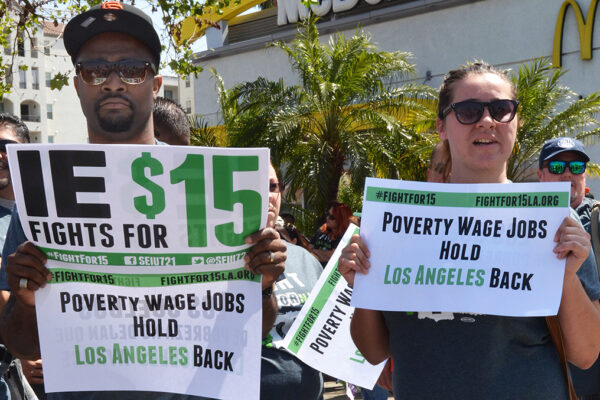At a time when evictions and mortgage defaults have been likened to an oncoming tsunami across America, a big-data study of loan-to-value ratios in the wake of the 2007-08 recession carries a cautionary forecast for vexing economic weather ahead:
The higher a worker’s outstanding mortgage relative to their home value, the worse their future income growth and job mobility.
Those were the key findings when four researchers, including two from Washington University in St. Louis’ Olin Business School, delved into the wage data and credit profiles encompassing 30 million Americans across 5,000 companies. They found a negative relationship between workers’ income and their home loan-to-value (LTV) ratio, especially when the home was underwater (higher principal owed than value).
For example, the scientists discovered that people with underwater mortgages earned $352 — or 5% — less monthly than workers with less mortgage debt relative to home values.
Compounded by credit and liquidity issues, these workers are virtually stuck, unable to move to a job with a better income or a new area, the researchers wrote in their study forthcoming in The Review of Financial Studies.
And it could well translate to the COVID-19 economic effects today.

“The impact of the current crisis on local economies varies widely across the U.S.,” said Radhakrishnan Gopalan, professor of finance at Olin and study co-author. “Our study highlights the difficulties someone in a worse-affected area may face in trying to pack up and move to a less-affected region. Furthermore, our study also highlights an important cost of homeownership: For instance, buying a home will constrain your labor mobility, and in the long run that may adversely affect your labor income.”
“This is one of the first studies to tie detailed credit histories to information on worker mobility and pay increases,” added co-author Barton Hamilton, the Robert Brookings Smith Distinguished Professor of Economics, Management & Entrepreneurship and director of the Koch Center for Family Business at Washington University. “Prior work has analyzed these factors in isolation and has not made the connection between the two.”
Seeking ways to scrutinize the effect of home equity and labor income, in addition to the mechanisms intertwined, the researchers used Equifax information and Corelogic house-price indices to drill down to study a random sample of 300,000 workers with an active mortgage over a 72-month period earlier in this decade.
They measured home equity as LTV — the unpaid mortgage vs. the market value — on the workers’ primary residence. They additionally accounted for home-value increases/decreases using ZIP-code level price fluctuations and controlled for local economic conditions. Moreover, they contrasted the income path of homeowners versus renters who worked at the same firm, were of a similar age and job tenure, and held a similar level of income and non-mortgage debt.
“This is one of the first studies to tie detailed credit histories to information on worker mobility and pay increases.”
Barton Hamilton
What the data essentially showed: Homeowners facing high LTVs were less likely to change homes, but more likely to change jobs, if they could. And renters working at the same companies and with similar job tenure faced no such issues. Additionally, homeowners with high LTVs faced slower income growth while renters faced no such penalties.
It wasn’t as cut and dried as a rent-vs.-own debate, though. Income and mobility for homeowners could vary. A worker could face relatively smaller income declines or find greater employment opportunities if they lived in a metropolitan area with more jobs — for instance, an IT worker in San Francisco/Silicon Valley — or a state with softer non-compete laws limiting movement within an industry.
Still, they found that declines in housing prices as a result of that 2007-08 recession suggested a 2.3% reduction in monthly wages economy-wide due to constrained mobility.
“If the adverse effects of the current pandemic on local economic conditions also spill over to house prices, then we will find ourselves with a number of underwater homeowners,” Gopalan said. “In that scenario, the effects we document will be very relevant.”

Gopalan and Hamilton were joined in the research by two former Olin PhDs, Ankit Kalda and David Sovich, who work at Indiana University and the University of Kentucky, respectively.
They wrote that a homeowner with an underwater mortgage were to face a new job offer in a different area, they were confronted with three (unappealing) prospects:
- Sell and swallow the shortfall — meaning they still must require some access to liquidity, despite being credit constrained.
- Retain the home and rent it out — meaning there will be no or negligible down payment on a new home in the new area.
- Walk away and default on the mortgage — meaning deeper credit issues.
In short, their mobility was as hampered as their current job situation, the co-authors said. A worker may not seek out better opportunities in the first place and, consequently, feel adverse effects on income because of an undermined bargaining power at the current workplace.
For the record, the median individual in their study group was 41 years old with an annual $41,015 salary; comparatively, the median person in the U.S. workforce overall in that time window was 41.9 with an annual $41,392 income, the co-authors wrote. The median loan: $192,400.
“While the ‘American dream’ is usually defined in terms of building wealth through home ownership, the financial crisis has revealed a few glaring holes in this story.”
Radhakrishnan Gopalan
“Our study highlights an important cost of home ownership,” Gopalan said. “While the ‘American dream’ is usually defined in terms of building wealth through home ownership, the financial crisis has revealed a few glaring holes in this story. Our study formally quantifies one important cost of following the ‘American Dream.’ A relatively safe way to own a house is to make sure one has sufficient down payment or home equity so that even if house prices fall, one is not stuck with an underwater mortgage. To this extent, our study recommends caution in pushing mortgages with less down payment.”
Hamilton added: “Our study highlights that policies affecting financial markets can directly impact the labor market as well. Businesses also need to be aware of the indirect costs that credit markets and home ownership may impose on mobility and the optimal allocation of their workforces.”
WashU Response to COVID-19
Visit coronavirus.wustl.edu for the latest information about WashU updates and policies. See all stories related to COVID-19.



